




 题 型
题 型
下面我花些时间介绍一下每个题型。口语考试一共考六个题目,每个题目有哪些值得思考和关注的问题呢?
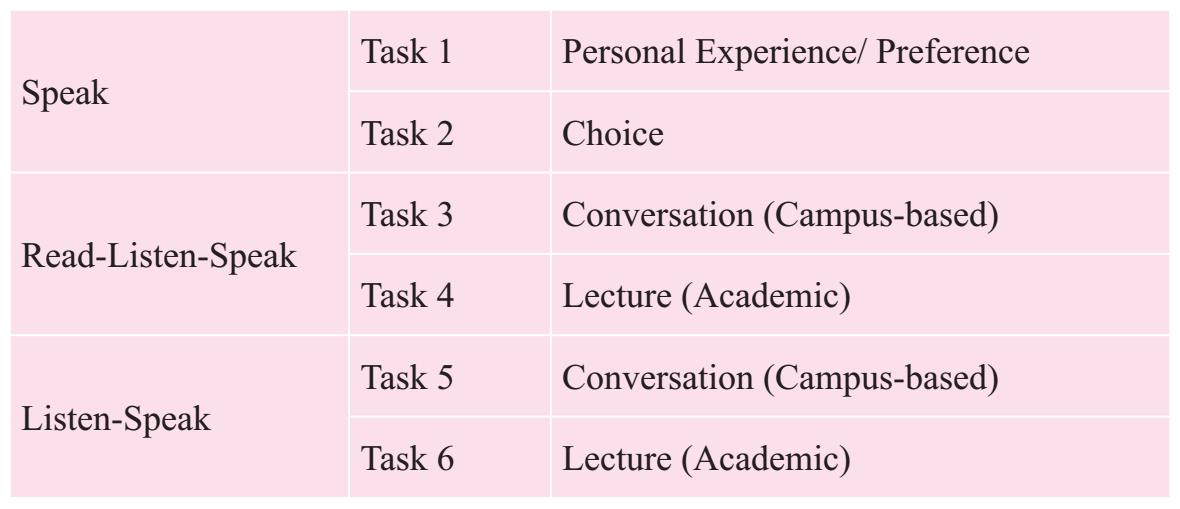
事实上,也有很多人将Task 3和Task 5归为一类,将Task 4和Task 6归为另一类,因为Task 3和Task 5的题材都是“Campusbased”(校园相关的),而Task 4和Task 6则是“Academic”(学术类的)。
Task 1考试形式:
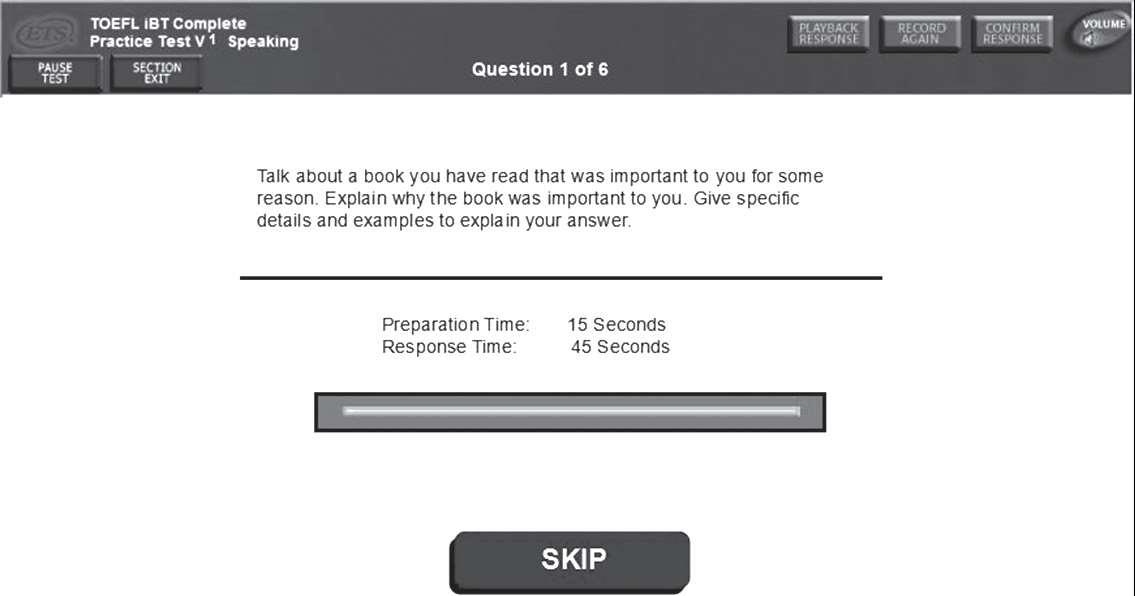
第1题我称之为独立问题(第1、2题都属于独立问题)。它往往要求考生讨论和谈及自己比较熟悉的人、事、地点等,目标就是希望通过考生的描述来体现他的语言水平。我想强调的是:没有任何人对你所描述的内容怀有幻想。换句话说,不需要花任何时间去准备一件有趣的、有说服力的、令人喜爱的奇闻异事。不需要!我们的目标是通过这次回答来体达出自己的语言水平。另外,既然题目是让我们回答一个问题,那么回答的时候就不能一直简单地复述答案本身,而应该花些时间在给出理由、给出细节上。这也是题目本身所关注的。比如下面这个题目:

Talk about a book you have read that was important to you for some reason. Explain why the book was important to you. Give specific details and examples to explain your answer.
TPO-1 TASK1

这个题目说得很简单,大家需要注意的是要求中的“specific details and examples”(具体的细节和例子)。这就是刚才我们所要求的在回答时不能简单地只给出答案,还需要对自己的答案进行丰富。这个丰富当然不只是简单地进行“paraphrase”(复述)而已。题目给出了两个方向,一个是“specific details”(具体的细枝末节),另一个是“examples”(例子)。这两个方向都是我们可以花时间去展开的。(事实上,展开一个话题显然并不只有讲细节和给例子这两种方法而已,还有很多方法。关于此部分内容,大家可以翻阅一下《文勇的新托福写作手稿》中关于话题展开的相关内容)
这道题有15秒准备时间,45秒答题时间。一般我们认为在45秒的答题时间内讲100—120个单词应该是没有问题的,给出这个单词数是为了告诉大家在写脚本的时候可以把内容写多长。下面让我们一起分析一下对于这个题目来说,一个比较好的回答脚本是什么。

参考答案:
One particular book that was important to me is Guns, Germs, and Steel by Jared Diamond, a geography professor at UCLA. The book is a nonfictional account of human development throughout history. It focuses on agriculture, culture, and science as the engines of civilization. It is a long book about a difficult subject,but the author writes it in a way that is interesting and fun to read. I learned about many interesting connections between geography and the rise and fall of different peoples throughout human history. It offers me a fresh and grand perspective of humanity.
——《新托福真题详解——口语分卷(第一册)第二版》

该文本的第一个优点是观点特别明确。这事实上也是对于所有回答第1题的同学的基本要求,即一定要在最开头部分有一个观点句。尽管我们平时说话时表达观点的方法有很多,但是对于一篇短文(特别是只有100词左右的脚本)来说,“开门见山”是最经济的方式。有时候我们会在网络上看到一些所谓的满分答案,它们采取特别华丽的导入、引入背景的方法,但不建议大家使用这些方法。
该文本的第二个优点是,文本提到了非常具体的书名及其作者。这个也就是ETS所强调的一定要言之有物、要有细节。尽管不建议大家去寻找很多新奇的案例,但是大家在回答时一定要讲述一个非常真实的话题,像具体的书名、具体的作者名就保证了回答的真实性。范例中所举的书可能没那么有名,但即便你举的例子是《安徒生童话》( Andersen’s Fairy Tales ),也毫无问题。
该文本的第三个优点是进行了有效的展开。我们可以看到文本第二句话就是对所提及的书的特质的进一步描述。更重要的是,在进一步的展开过程中不仅介绍了书本身,还阐述了文本作者能够从中学到的知识。这种层面的展开是必要的,毕竟这个题目问的不是“某一本书的内容是什么”,而是要强调“这本书为什么对你来说重要”,那么“为什么重要”这一点是一定需要被阐述的。换句话说,文本中的最后两句话既是文本作者对从书中学到的知识的总结,也是对题目的点题,显得格外重要。
Task 2考试形式:
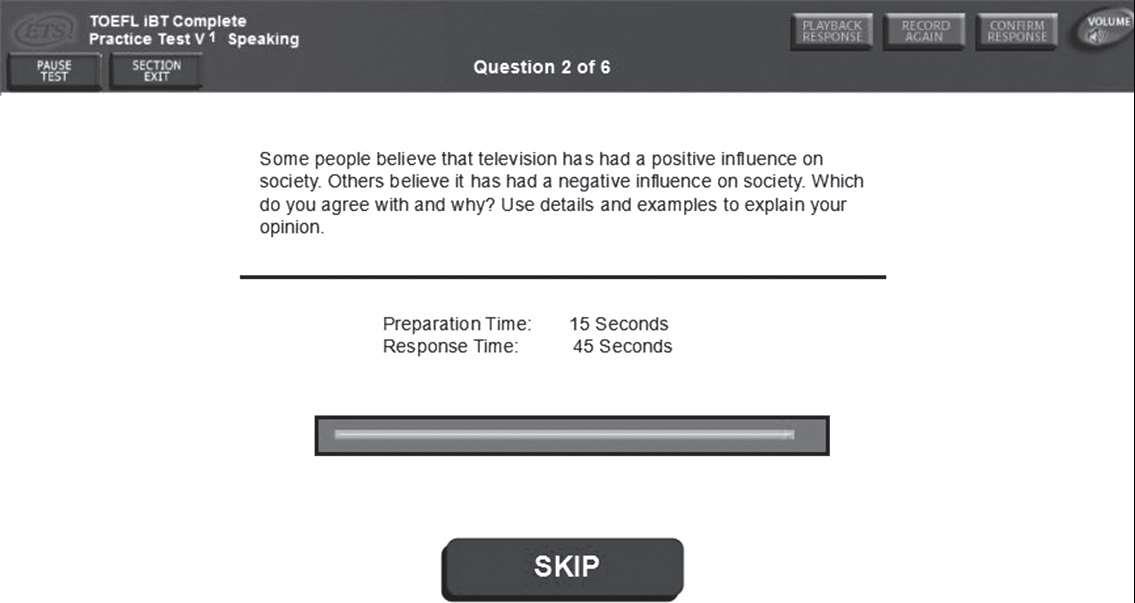
第2题往往是让考生在两种行为或者观点之中选择一个。此时依旧要提醒大家: 两个中选一个,并没有任何一方是受到青睐的。也就是说,你可以选A,也可以选B,两者任选其一 。大家也应该知道选择并没有对错之分,选择本身并不会影响评分。值得注意的是,即便你要走中间路线,也就是选择的答案是“it depends”,也不会影响最终得分。比如,题目问的是:“在家里学习好还是在图书馆学习好?”你的回答是:在家里学习课外读物比较好,在图书馆学习数理化比较好。这个答案是明确的,完全没有问题,只要你展示的语言水平足够好,也可以拿到满分。
一定要注意,ETS对我们的要求是“观点明确”,但明确并不意味着观点一定要极端。

Some college students choose to take courses in a variety of subject areas in order to get a broad education. Others choose to focus on a single subject area in order to have a deeper understanding of that area. Which approach to course selection do you think is better for students and why?
TPO-2 Task 2

大家看到的这个题目就是独立问题第2题的样子了,问得也很简单。同学们注意,题目中并没有特别强调“examples and details”,但这并不意味着“examples and details”是不重要的,而是意味着我们不能只是简单地用举例和细节来限制自己的说明过程。论述方法
 除了举例和细节之外,还有因果、比较、分类、目的等,都是可以使用的。我建议大家最好能作一下分类,逐一练习每一种论述方法的语言表达。当你把每一种论述方法的语言表达都训练得很熟练时,口语自然可以脱口而出了,这不是件坏事情。
除了举例和细节之外,还有因果、比较、分类、目的等,都是可以使用的。我建议大家最好能作一下分类,逐一练习每一种论述方法的语言表达。当你把每一种论述方法的语言表达都训练得很熟练时,口语自然可以脱口而出了,这不是件坏事情。

参考答案:
From my point of view, college students should both broaden and deepen their knowledge. I think that at the beginning of college , perhaps for the first and second year students, it is good to receive a broad education. Taking a wide range of courses allows these students to become knowledgeable about many subjects and makes them better-rounded. Once students decide on a major in their third and fourth year , focusing on that single subject is the best, as this will allow them to truly excel in the field they choose to enter.
——改编自《新托福真题详解——口语分卷(第一册)第二版》

我故意找了一篇在传统意义上是中立的文章给大家看。答案中的观点并不在两个极端中的任何一边。第一句话说的是大学生不应该只拓宽知识面,也应该深化自己的知识。观点很明确,但并不极端。
在给出观点之后,这个段落非常清楚地分为两个部分:第一部分说的是读大学的前期;第二部分则是读大学时已经决定所读专业的后期。这种分类方法使得听者感觉层次特别清晰。在前面我也提到论述方法有很多种,其中有一个大类,就叫作“分类”。大家不妨在平时练习的时候,对同一个题目在已经作答完成、已经修改完脚本之后,尝试使用多种其他可能的方式,来对同一个段落、同一个文本进行展开。
Task 3考试形式:
① Reading
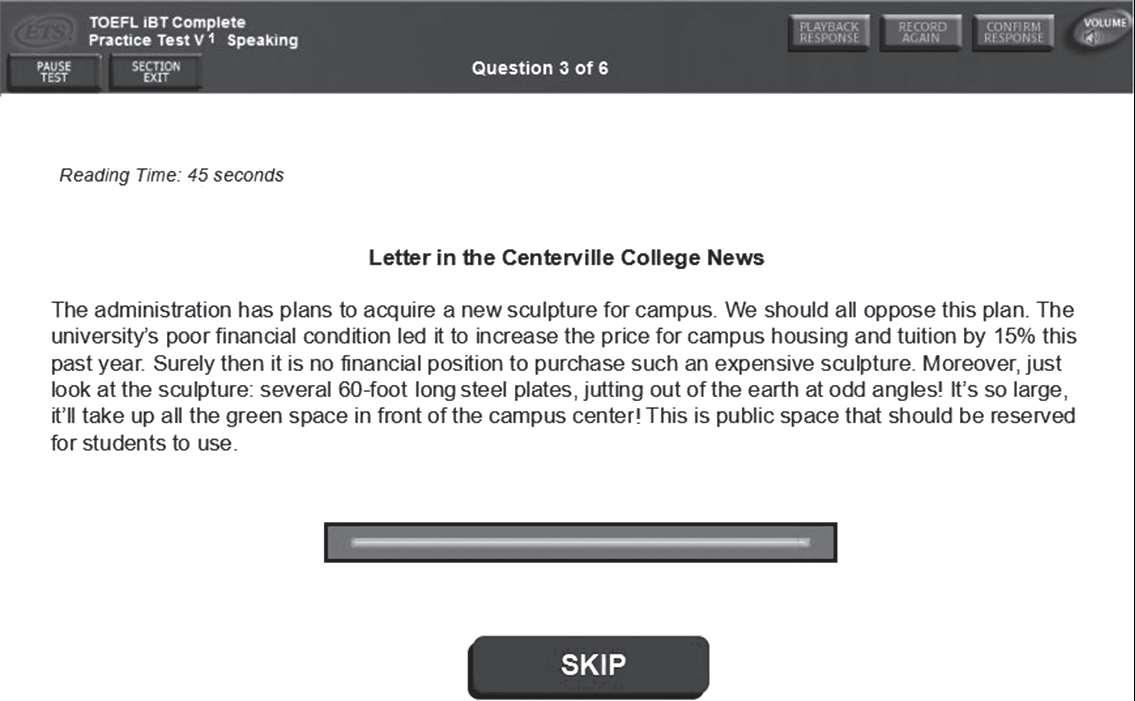
②Listening
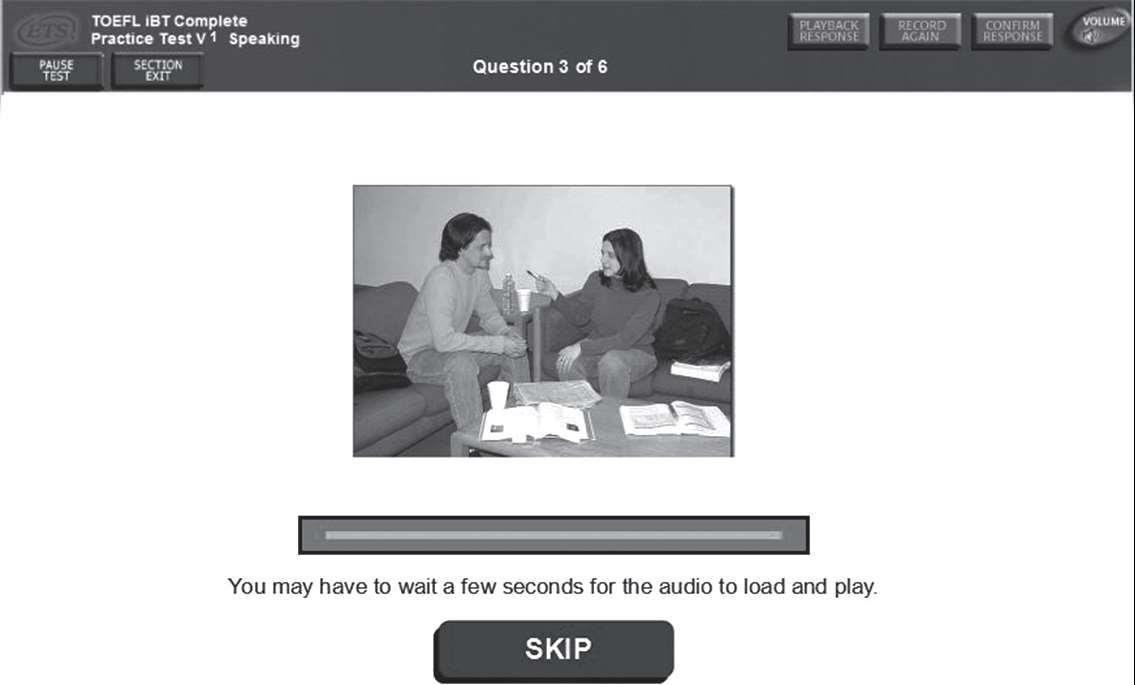
③Speaking
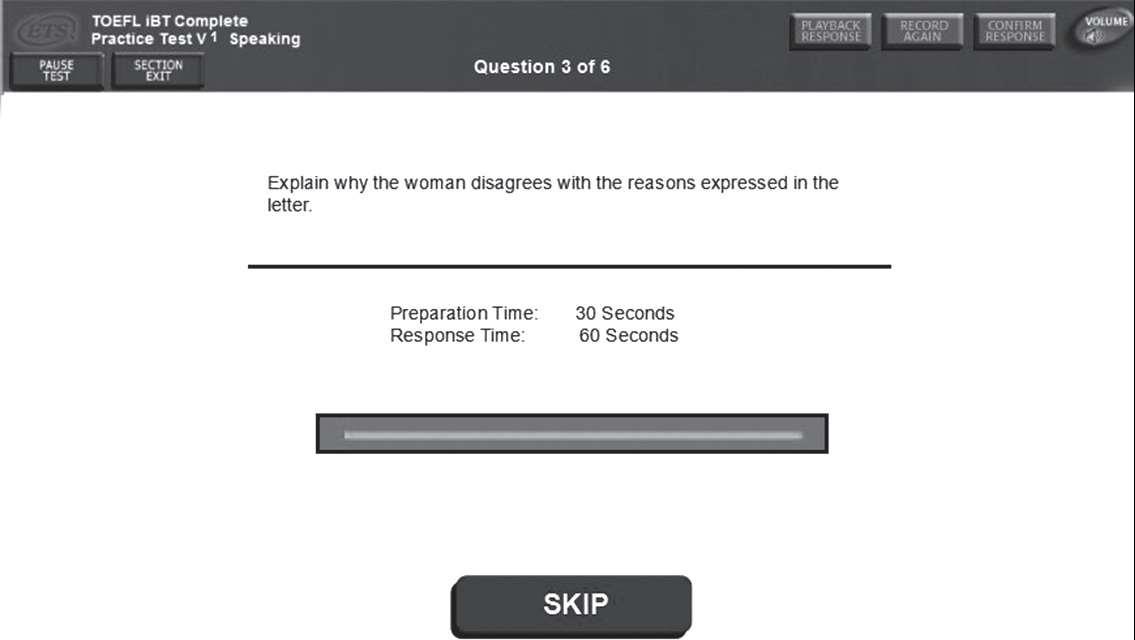
第3题和第4题在考试形式上很相似,都包括听力、阅读和口语。一般来说,第3题与校园生活息息相关。值得注意的是,在回答第3题时,我们不需要表达任何一丁点自己的观点,只需要描述清楚听到的材料与读到的材料之间是什么样的关系即可。一般来说,两者之间是非黑即白的,即要么是赞同,要么是反对,很少有中立的态度。但也必须再次强调,在作答第3题时盲目地求多不可取,回答的内容越长并不意味着信息越丰满。在信息准确的前提下,应该是越简洁明了越好。另外,在这个题目中,笔记的内容也非常重要。

Reading
Letter in the Centerville College News
The administration has plans to acquire a new sculpture for campus. We should all oppose this plan. The university’s poor financial condition led it to increase the price for campus housing and tuition by 15% this past year.Surely then it is no financial position to purchase such an expensive sculpture. Moreover, just look at the sculpture:several 60-foot long steel plates, jutting out of the earth at odd angles! It’s so large, it’ll take up all the green space in front of the campus center! This is public space that should be reserved for students to use.
Listening
Student A
Did you see Paul’s letter in the paper about the new sculpture?
Student B
Yeah, but it was totally unconvincing. His reasons for opposing the plan were just totally off. I’m glad we’llfinally have some nice arts on campus. I’d like to shake the donor’s hand and say “Thank you”.
Student A
What do you mean, “the donor”?
Student B
You didn’t know? An anonymous donor is paying the bill for most of the sculpture.
Student A
Not the university?
Student B
No. His assumptions about who’s paying for it are all wrong.
Student A
Still I wonder if he has a point about the space it’ll take up.
Student B
Well, you know why Paul is upset? He and his friends are always out there on the lawn, right where the sculpture will be, kicking around the soccer ball. Now they’ll just have to use another part of the campus to play.
Student A
Oh, so, he just doesn’t want to have to move.
Student B
Yeah. For him, it’s sculpture versus convenience.
Question
Explain why the woman disagrees with the reasons expressed in the letter.
TPO-1 TASK 3

如上是一个范例。一开始我们会有些时间来读阅读文本,之后会听到一段对话,最后直接答题。千万要注意,题目的要求是描述清楚听力材料中女士的观点并且解释她为何持有这种观点。这个时候的笔记也应该是以寄生式笔记为最优。对于第3题,可以讲的地方还是挺多的,我会有选择地进行重点讲述。比如,如何尽可能快地找到阅读文本的观点并且对其进行总结?

参考答案:
The school is planning to put a new sculpture in, and Paul wrote a letter against the sculpture plan. The woman is looking forward to seeing some good arts on campus and disagrees with Paul’s letter for two reasons. First, Paul argued in his letter that the sculpture would cost too much money that the university can’t afford to spend, but the fact is that the sculpture is being paid for mostly by a donor.Also, she knows that Paul and his friends like to kick the soccer ball around in front of the campus center, and once the sculpture was built, they could not keep playing soccer there any more. That’s the reason why they oppose the statue plan.
——改编自《新托福真题详解——口语分卷(第一册)第二版》

参考答案较好地回答了题目本身,文中两个理由正好针对了Paul在阅读段落中所提出的两个问题。我想这个答案非常深刻地体现了为什么在一开始看阅读文本时就要求大家记笔记,因为我们会发现口语答案完全是依照阅读笔记来进行展开的。
参考答案的最开头部分,先是非常简单明了地说出了阅读文本的内容,也就是学校打算放置一座雕像,而Paul写了封信表示反对这个雕像计划。参考答案的第二句话非常清楚地说明了对话中女士对信件中男士的观点并不赞同,她给出两个理由。第三句话是理由一:Paul觉得放置雕塑太昂贵,但费用并不是由学校来承担,而是主要由不具名的捐赠者捐款。第四句是理由二:关于否占空间这一点,她知道Paul会提出这一点并写信进行反驳,因为Paul和他的朋友经常在那里踢球,所以雕像会占据他们的活动空间,而不是大家的活动空间。
阅读材料讲述了两个要素,因此听力材料也会讲述两个要素,而我们的口语回答也应据此展开,分为两点。另外,因为听力部分特别长,而且只放一遍,所以我们很难把听力材料中所有的内容全都记录下来。我们需要依据阅读材料中女士对男士的这两点是如何反驳的,在笔记上做出相应的标记。只有这样才能更好地用口语表述。这两点的反驳方法并不一样,我会在随后的相应章节中进行详细阐述。第一个小观点(subtopic)采取的反驳方式是直接对对方所述论据的真实性进行反驳。换句话说,就是直接对阅读材料中所描述的“花费了大量的钱”这一点、这个事实、这一论据本身的真实性进行质疑,因为实际上对话中的女士强调钱主要是来自捐赠者而并非大学本身。第二个小观点(subtopic)的反驳使用的是给出新论据、得出相悖结论的方法。换句话说,对话中的女士并没有讨论雕像是否会侵占大家的公共空间,对于阅读材料中所论述的论点并没有直接反驳,而是给出自己的新论据,然后得出相悖结论。新论据就是绿地实际上是写信的男子和他的朋友用来踢球的地方。
Task 4考试形式:
①Reading
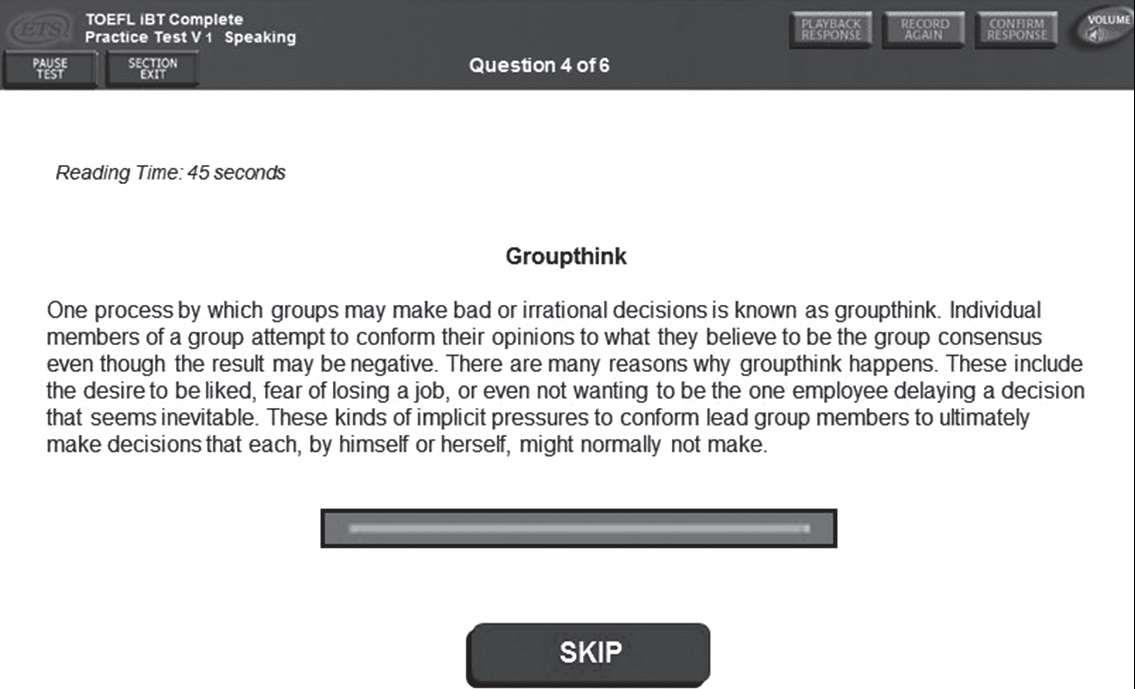
②Listening
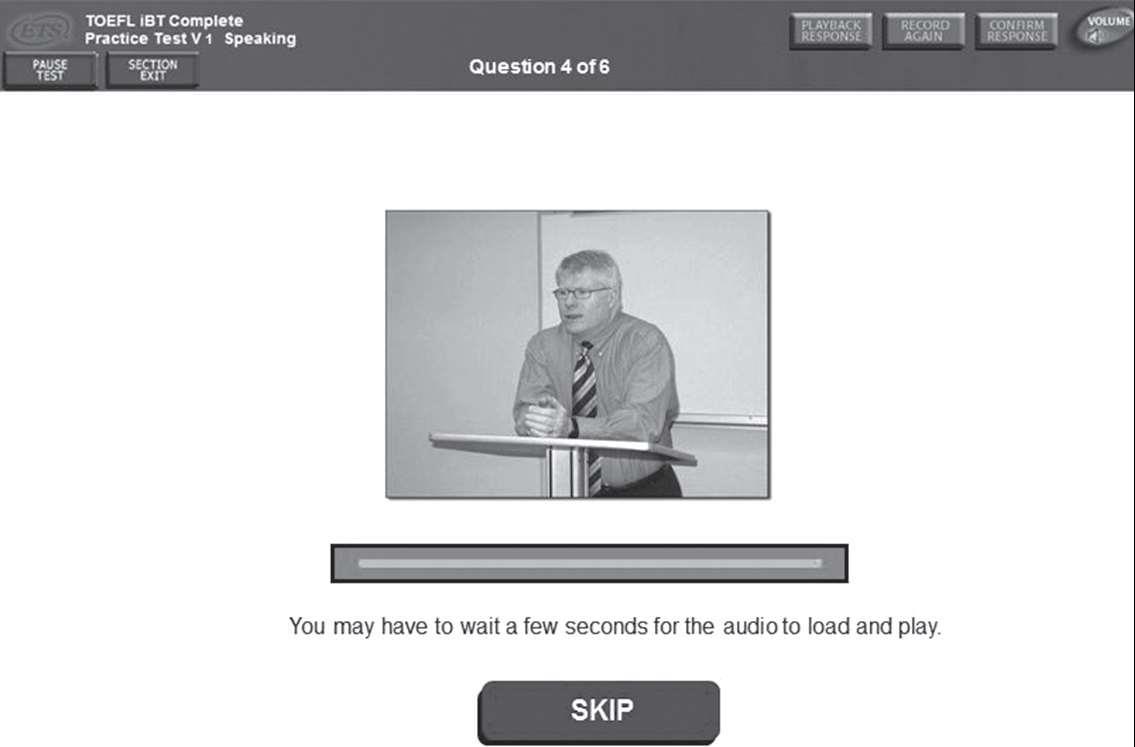
③Speaking
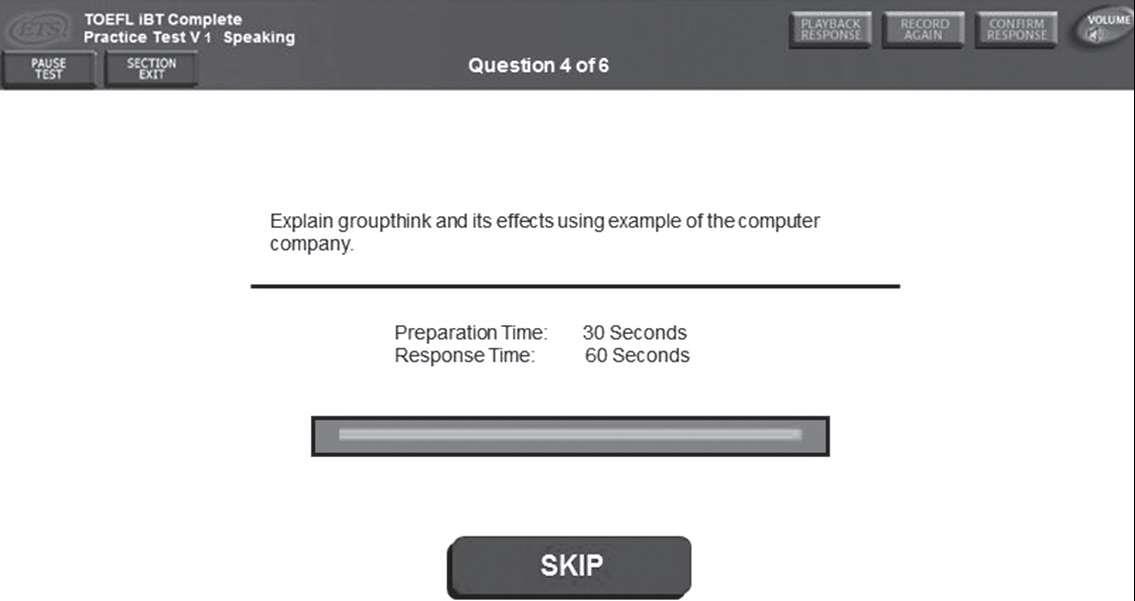
第4题的考试形式和第3题很相似,都是需要先阅读、再听录音、最后才是口语作答。与第3题的校园题材不同的是,第4题往往是学术类文章。所以在第4题中,考生们读到的文章是学术小短文,听到的是老师关于学术话题的讲座节选。很多考生会认为第4题比第3题更难,正是因为第4题是学术类题材,所以它往往在背景知识方面讲述的是考生们以前所不熟悉的话题;而第3题毕竟是校园话题,看过电视、对大学生活有所了解的同学,猜一猜也总是能猜到的。事实上,我在这里也想提醒大家:第4题尽管涉及生命科学、社会科学、自然科学和人文科学四个大的方面,但这些学术题材是不需要我们对它们有任何的深入背景了解的;如果水平足够高(听力和阅读水平足够高),即便有大量专有名词,我们在不理解专有名词的情况下也能正确复述,而且文章中真正需要理解之后才能往下复述的内容也会有相应的定义部分(这个定义恰好能帮助我们了解文章的主旨)。
总体而言,大家可以将阅读材料和听力材料分别看作是课本和老师的讲解。大家需要注意的是:在大学的课堂上,老师讲解的内容并不一定都是正面地支持课本的内容,也有可能是对课本的内容提出反例。这可能和传统的中国学生所了解的并不一致。既然一个是课本、一个是老师上课讲的话题,那么大家要知道老师上课讲的东西与课本内容肯定是特别相关的。讲座内容往往会更加具体、更加详细,是对某一个具体案例的扩展或者是举反例,运用到的正是课本或者是考生面前阅读文章中的具体概念。最终的口语作答,有可能是要求考生根据听到的讲座的具体内容,比如说是一个例子或者是一个扩充、扩展,来解释阅读文章中的某一个定义和概念;也有可能是因为听力材料中描述了一个解决方案,那么就要求考生根据听力材料中刚刚所听到的解决方案来说明其是否可以解决阅读文章中的所提到的特定问题。好了,下面我们一起来看一个具体案例,试着找一找这种先读完课本内容,再听老师对课本内容的阐述并且尝试作答的感觉。

Reading
Revealing Coloration
Many animals use coloration to protect themselves from predators. One defensive strategy involving the use of coloration is what is known as revealing coloration.Animals employing this strategy have an area of bright color on some part of their body; this bright color is usually hidden from predators’ view. When approached by a predator, the animal suddenly reveals the area of bright color; this unexpected display of color startles or confuses the predator and provides the would-be prey with an opportunity to escape.
Listening
Professor
There is a large tropical insect called the Peanut Bug,yes, like the peanuts that you eat. Um and the Peanut Bug’s front wings are colored so that they blend in with their surroundings. But its back wings, which are usually closed and hidden, have these bright colorful spots on them and when the Peanut Bug is attacked, it suddenly opens its back wings and out pops these big bright colors. And that surprises the predator and gives the Peanut Bug a chance to get away.
Um and then you have a butterfly called the Morpho Butterfly, and parts of the Morpho Butterfly’s wings are very shiny. They reflect a lot of sunlight. When this butterfly is resting, this shiny part of its wings is hidden. Now Morpho Butterflies are often attacked by birds. So when a bird approaches, the Morpho flies away. And when the Morpho flaps its wings, all the bird can see are flashes of light reflected from the Morpho’s wings. Those flashes of light make it very difficult for the bird to follow the Morpho, and the Morpho is usually able to get away.
Question
Using the examples of the Peanut Bug and the Morpho Butterfly, explain the concept of revealing coloration.
TPO-8 TASK 4

首先,我们要看清楚每道题目的问法,并据此来安排我们将要回答的问题。事实上,第4题都是让你用听力材料中所听到的内容来进一步解释阅读中所阐述的定义。也正因为如此,我们在读阅读材料的时候就应该对概念的定义是什么有清楚的认识,并且能在听录音的时候能围绕着特定的定义来记录,这样才能正确地找到听力文本与阅读文本之间的关系。譬如上面这个题目,我们来看一下参考答案。

参考答案:
Revealing coloration is a technique that many animals use when they are being preyed upon, as it helps them escape. These animals have a colorful or bright part of their body that usually remains hidden. When in danger, they reveal this part, which surprises the predator and allows them to escape. The examples the professor uses are of the Peanut Bug and the Morpho Butterfly. The Peanut Bug has bright, colorful back wings that it shows when it is attacked, and the bright colors distract long enough for the bug to escape. The Morpho Butterfly has very shiny wings,so when it is chased by birds, it reflects the sunlight and makes it hard for the birds to follow it.
——《新托福真题详解——口语分卷(第一册)第二版》

参考答案是一份优秀答案。它在第一句话中就清楚地解释了到底什么是“revealing coloration”(警戒色)。第二句话对于什么是警戒色进行展开,事实上这也是阅读材料中所提及的东西。随后就清楚地描述了听力材料中的两个例子到底是如何印证我们的定义的。“Peanut Bug”和“Morpho Butterfly”都是将定义重新使用了一遍。其实这个题目考查的就是我们的复述能力,即课本中的定义和老师的解释是否能在最后的复述过程中有所表达,是否能将老师讲的东西和课本中所描述的概念结合在一起进行理解和分析。第4题就是模拟了这样的学习过程。
Task 5考试形式:
①Listening
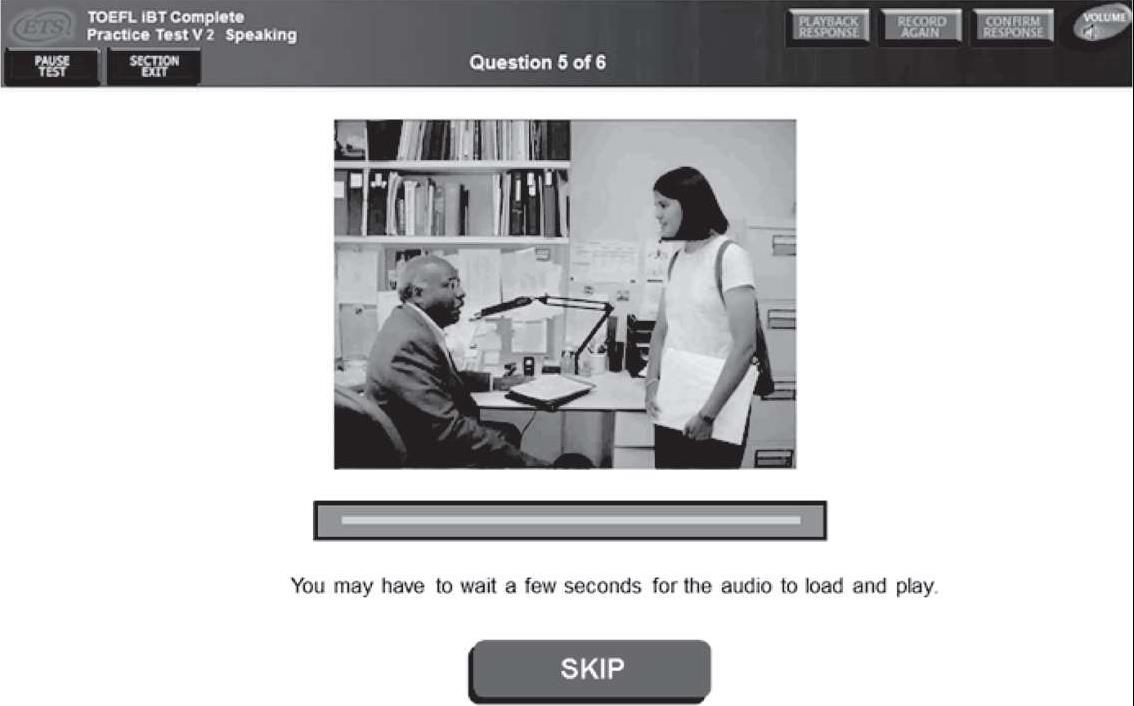
②Speaking
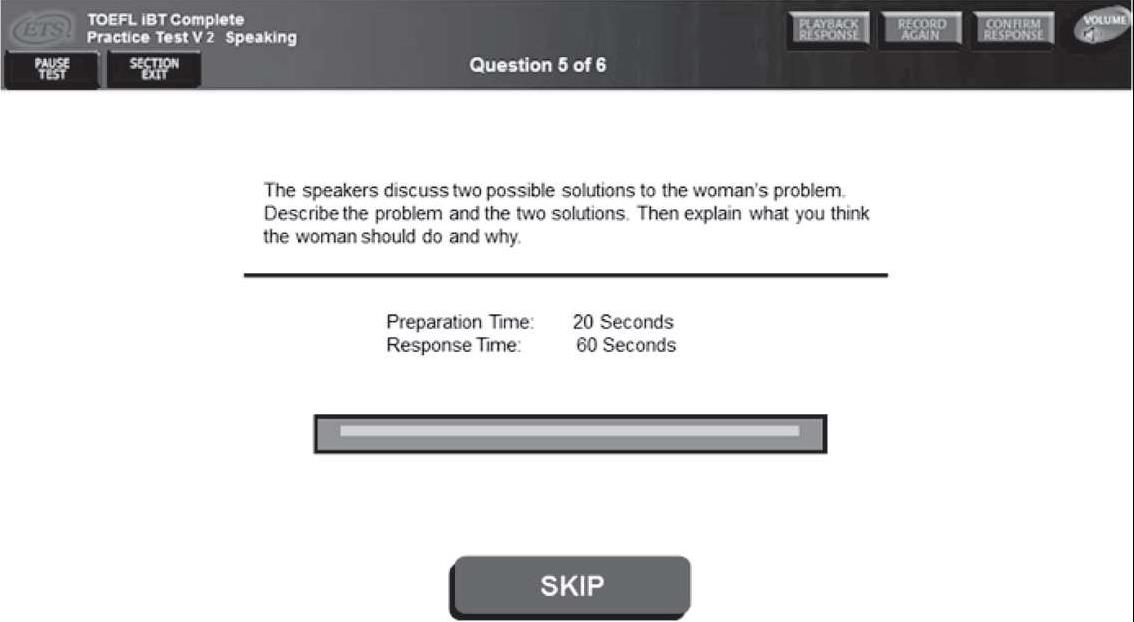
第5题和第6题也是很类似的,它们和第3题、第4题比起来,可能在考试形式上综合的内容会更少一点。因为第3题、第4题综合了阅读、听力和口语,而第5题和第6题则是只综合了听力和口语。注意:第5题和第6题是没有阅读部分的。第5题和第6题在安排上(即形式上)很类似,题材方面跟第3题、第4题一样,分别是校园话题(第5题)和学术话题(第6题)。
事实上,对于第5题,我强烈建议大家带着问题来听听力文本的内容。第5题中有可能是两个学生面临着共同的问题,那么他们可能就需要一起来想出解决方案;另外一种情况可能是一个学生和一个老师或者其他人分别提出对策,那么这个时候就会同时有两个方案。在对话结束之后,考题往往要求考生先讲述一下对话之中到底有哪些具体的问题,然后再说一说自己会偏向对话中所给出的两个解决方案中的哪一个,之后再进行作答。需要注意的是,在第5题的答题过程中是可以加入自己的经历、自己的例子,甚至是自己的理由的。也就是说,回答第5题时,前半段是在复述问题以及所给出的解决方案,后半段则是根据自己的想法和理解来讲述一个具体的观点,并通过自己的经历和例子来证明。当然,我也要再次强调:尽管文章会给出两种解决方案,但实际上选择这两种方案中的任何一种其实都不会影响各位考生的分数。评分人在乎的不是选择哪一种方案,而是我们用怎样的语言以及是否能够流利清楚地表达并论证自己的观点。

Listening
Student A
Susan! What happened to your arm?
Student B
That’s my wrist actually. I sprained it last weekend.And I’m kind of upset about it, because I’m supposed to play the violin in my string quartet’s big concert next week.We’ve been practicing for weeks and we’ve already sold a bunch of tickets.
Student A
Uh...I’m sorry to hear that. What are you gonna do?
Student B
Well. I was thinking about trying to play anyway.I mean I really don’t want to let the other three group members down. Plus the doctor said my wrist should be feeling better by then.
Student A
Oh. Okay, so, problem solved, right?
Student B
Not exactly. I’m worried that I’m gonna be out of practice, like I haven’t been able to play the violin since I sprained my wrist. What if I don’t play well? I’d make the rest of the group sound bad.
Student A
Why don’t you get somebody else to take your place?
Student B
Well there is only one other person I know of who could do it, and that’s Jim. He is a great violinist, and I’m sure he’d say yes. The thing is that he is not very reliable.I mean I’m in the orchestra with him and he is always showing up late for rehearsals.
Student A
Oh, so you’re not sure you can depend on him.
Student B
Exactly, and we have less than a week left to rehearse for the concert, we’d really need him to show up on time for all of our rehearsals.
Question
Briefly summarize the woman’s problem. Then state which solution you would recommend. Explain the reasons for your recommendation.
TPO-5 TASK 5

一定要注意题目的问法并不是每次都一模一样的,所以看清楚问法还是很重要的。

参考答案:
The woman is supposed to play the violin in her quartet’s big concert next weekend, but she recently sprained her wrist and so is not sure if she can practice or play well in the concert. She and the man come up with two possible solutions. She can either play in the concert despite her injury or she can ask a friend to play in her place; however, her friend is somewhat unreliable and comes to practice late often. I believe she should ask her friend to play in her place. While he may be unreliable, he will still be able to practice this week before the concert,while the woman cannot practice until her injury heals. A little bit of practice is better than none.
——《新托福真题详解——口语分卷(第一册)第二版》

在回答时,第一句往往应该先尝试描述问题是什么,即“The woman is supposed to play the violin in her quartet’s big concert next weekend, but she recently sprained her wrist and so is not sure if she can practice or play well in the concert”,然后飞快地描述两种可能的解决方案,即“play in the concert despite her injury”和“she can ask a friend to play in her place”。最后一定要注意,回答第5题时必须要有自己的观点,而且使用的论据也不能来自听力材料原文。回答时应有大概一半的篇幅是在阐述自己对于两种“solutions”的态度、观点以及原因(为什么自己会选择其中的某一种方案)。
Task 6考试形式:
①Listening
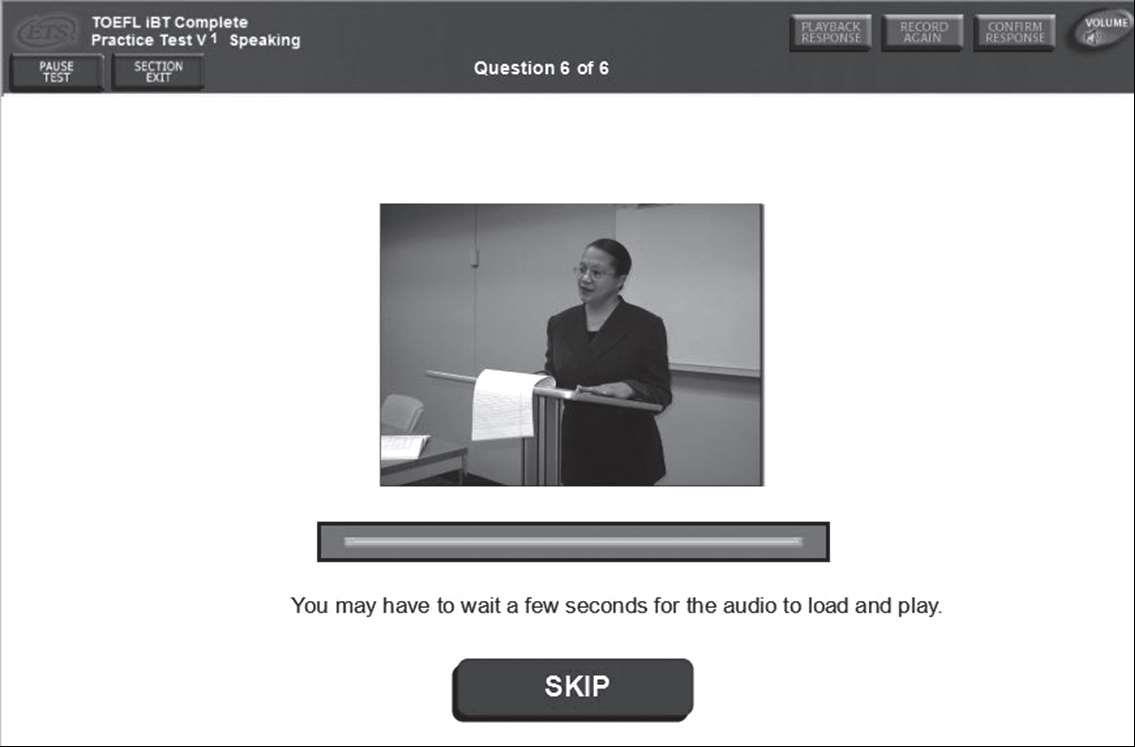
②Speaking
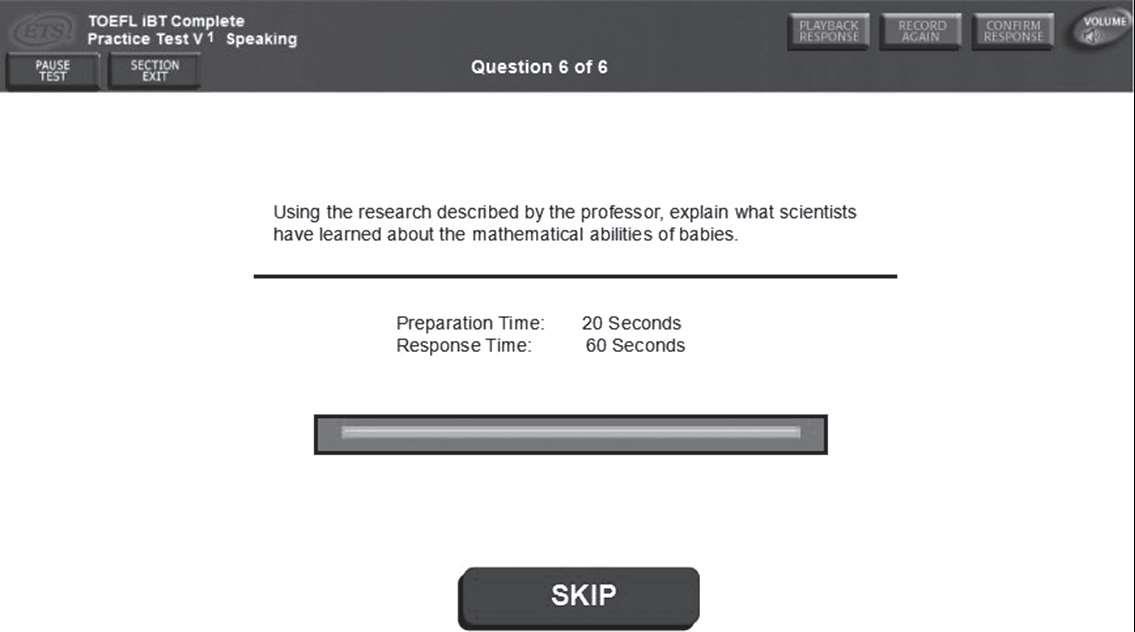
刚刚我们已经知道了第6题和第5题在形式上很类似,都是先听录音,然后再用口语作答。但是题材跟第5题不一样,第6题是学术话题。通常我们可以把第6题想象为老师在对某个观点进行具体阐述,分为两个部分:前半部分是在阐述概念、观点、现象、问题本身,后半部分则是对其进行展开论述,并通过说明性的例子来证明。
考题自然是考查大家是不是把这个段落听懂了,是不是能够理解真实的大学课堂上所描述的概念到底传递了哪些信息。那么作答的时候自然要求考生使用刚刚听到的讲座中的观点和例子来描述一些概念并解决问题。
在听的过程中有一个非常重要的任务,就是区分清楚我们听到的内容之中,哪些内容可以最好地帮助我们说服听众,哪些内容是老师所讲述的关键信息。因为,毫无疑问,听力文本非常长,其中的信息也非常多,的确是每一句话似乎都能对所介绍的概念起到一些作用,只不过有一些可能是起到非常重要的作用,有一些可能是起到比较次要的作用。在答题过程中(一共只有60秒),我们还要花一些时间对题目进行思考,所以没有时间把所有的内容、每一句话都复述出来。我们必须具备一个能力,就是筛选最重要的、最核心的信息,然后对信息进行逐一复述。自己的观点在这里则不需要得到表达。
下面我们来看一个具体的题目,然后分析一下题目中到底关注哪些内容。

Listening
Professor
One of the hardest parts of teaching is keeping your students’ attention. Now, the key to doing this is understanding the concept of attention.
Basically, there are two types of attention. The first type is active. Active attention is voluntary. It’s when you intentionally make yourself focus on something. And since it requires effort, it’s hard to keep up for a long time.
Ok, so... um... let’s say you’re teaching a... a biology class, and today’s topic is “frogs,” all right? You’re standing at the front of the room and lecturing [make the state sounds very boring]: “A frog is a type of animal known as an amphibian.” Well [chuckling], this isn’t necessarily going to keep the students’ interest. But most of them will force themselves to pay active attention to your lecture. But it’s only a matter of time before they get distracted.
Now the other type of attention is passive attention when it’s involuntary. Passive attention requires no effort because it happens naturally. If something’s really interesting, students don’t have to force themselves to pay attention to it. They do it without even thinking about it.
So, back to our biology lecture, you start talking about frogs, and then you pull a live frog out of your briefcase.You’re describing it while you hold it up, show the students how long its legs are and... and how they’re used for jumping, for example. Then, maybe you’ll even let the frog jump around a bit on the desk or the floor. In this case, by doing something unexpected, something more engaging,you can tap into their passive attention and it can last much longer than active attention. As long as the frog is still there, your students will be interested.
Question
Using points and examples from the talk, explain the difference between active and passive attention.
TPO-6 TASK 6
参考答案:
There are two types of attention: active attention and passive attention. Active attention requires effort;it is when people force themselves to pay attention and so oftentimes doesn’t last a long time. Passive attention occurs when we involuntarily pay attention, which happens when we find something very interesting. The professor describes an example of each. If a biology professor gives an experiment-free lecture on frogs, the students will have to use active attention to listen to the lecture, since it will be boring. But such effort will not last long. However, if the professor shows the students a live frog, they will be naturally interested, and will pay attention all the time without any conscious effort.
——《新托福真题详解——口语分卷(第一册)第二版》

回答第6题时,毫无疑问,我们应该先尝试给出定义阐述。比如,这道题目问的是“active attention”和“passive attention”的差异,那么就会有一到两句话是根据听力材料提到的内容来对其进行展开。在本回答中就告诉了大家到底什么是“active attention”,什么是“passive attention”。如果可能的话,再尝试说明在听力材料中听到的论述方法是什么。比如在参考答案中有细致的描述“The professor describes an example of each”。“an example”就是对于“professor”在描述两个定义时所使用的论述方法的基本展开。剩下的就是详细地复述两个例子本身了。
当看到这里,我们会发现,事实上除了第1、2题外,第3—6题的解答在很大程度上都依赖于我们的复述能力,这也说明为什么复述能力特别重要。